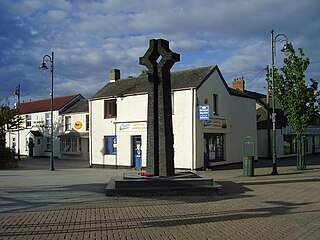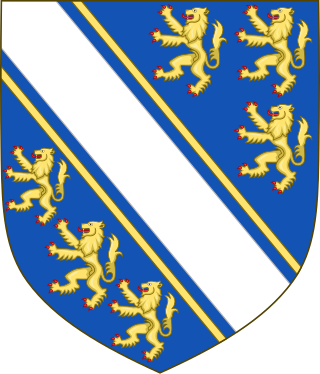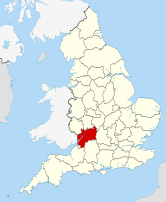
Gilbert de Clare, 6th Earl of Hertford, 7th Earl of Gloucester was a powerful English noble. He was also known as "Red" Gilbert de Clare or "The Red Earl", probably because of his hair colour or fiery temper in battle. He held the Lordship of Glamorgan which was one of the most powerful and wealthy of the Welsh Marcher Lordships as well as over 200 English manors.

Caldicot is a market town and community in Monmouthshire, Wales. The town is located between Chepstow and the city of Newport. The site adjoins the Caldicot Levels, on the north side of the Severn Estuary. The population of the built-up area was around 11,000. It has a large school, Caldicot School, and is known for its medieval castle. The built-up area includes Portskewett. Caldicot had a population of 9,604 in 2011.

Humphrey (VI) de Bohun, 3rd Earl of Hereford and 2nd Earl of Essex, was an English nobleman known primarily for his opposition to King Edward I over the Confirmatio Cartarum. He was also an active participant in the Welsh Wars and maintained for several years a private feud with the earl of Gloucester. His father, Humphrey (V) de Bohun, fought on the side of the rebellious barons in the Barons' War. When Humphrey (V) predeceased his father, Humphrey (VI) became heir to his grandfather, Humphrey (IV). At Humphrey (IV)'s death in 1275, Humphrey (VI) inherited the earldoms of Hereford and Essex. He also inherited major possessions in the Welsh Marches from his mother, Eleanor de Braose.

Humphrey IV de Bohun, 2nd Earl of Hereford, 1st Earl of Essex was an Anglo-Norman nobleman and soldier who served as hereditary Constable of England.

Anne of Gloucester, Countess of Stafford was the eldest daughter and eventually sole heiress of Thomas of Woodstock, 1st Duke of Gloucester, by his wife Eleanor de Bohun, one of the two daughters and co-heiresses of Humphrey de Bohun, 7th Earl of Hereford, 6th Earl of Essex (1341–1373) of Pleshey Castle in Essex.

Caldicot Castle is an extensive stone medieval castle in the town of Caldicot, Monmouthshire, in southeast Wales, built near the site of Harold Godwinson's former Saxon castle by the Norman earls of Hereford from about 1100. The castle became a Grade I listed building on 10 June 1953.

Miles FitzWalter of Gloucester, 1st Earl of Hereford was a great magnate based in the west of England. He was hereditary Constable of England and Sheriff of Gloucestershire.

Humphrey (VIII) de Bohun, 6th Earl of Hereford, 5th Earl of Essex of Pleshy Castle in Essex, was hereditary Constable of England. He distinguished himself as a captain in the Breton campaigns of the Hundred Years' War, playing a part in winning the Battle of Morlaix (1342) and the Battle of La Roche-Derrien (1347).

William Bourchier, 1st Count of Eu, was an English knight created by King Henry V 1st Count of Eu, in Normandy.
Henry FitzMiles, Baron Abergavenny was a Norman baron and a Marcher Lord in the Welsh Marches.
This article is about the particular significance of the century 1301–1400 to Wales and its people.
This article is about the particular significance of the century 1201–1300 to Wales and its people.
This article is about the particular significance of the century 1101–1200 to Wales and its people.

Eva Marshal (1203–1246) was an Anglo-Norman noblewoman, daughter of William Marshal and Isabel de Clare, the Earl and Countess of Pembroke. She married William de Braose, a marcher lord.
Bertha of Hereford, also known as Bertha de Pitres, was the daughter of Miles de Gloucester, 1st Earl of Hereford, and a wealthy heiress, Sibyl de Neufmarché. She was the wife of William de Braose, 3rd Lord of Bramber to whom she brought many castles and Lordships, such as Brecknock, and Abergavenny.
Eleanor de Braose was a Cambro-Norman noblewoman and a wealthy co-heiress of her father, who was the powerful Marcher lord William de Braose, and of her mother, Eva Marshal, a co-heiress of the Earls of Pembroke. Her husband was Humphrey de Bohun, heir of the 2nd Earl of Hereford, by whom she had children, including Humphrey de Bohun, 3rd Earl of Hereford and Gilbert de Bohun.
Humphrey III de Bohun of Trowbridge Castle in Wiltshire and of Caldicot Castle in south-east Wales, 5th feudal baron of Trowbridge, was an Anglo-Norman nobleman and general who served King Henry II as Lord High Constable of England.
Sibyl de Neufmarché, Countess of Hereford, suo jure Lady of Brecknock, was a Cambro-Norman noblewoman, heiress to one of the most substantial fiefs in the Welsh Marches. The great-granddaughter of Gruffydd ap Llywelyn, king of Wales, Sibyl was also connected to the nobility of England and Normandy. Sibyl inherited the titles and lands of her father, Bernard de Neufmarché, Lord of Brecon, after her mother, Nest ferch Osbern, had declared her brother Mahel to have been illegitimate. Most of these estates passed to Sibyl's husband, Miles de Gloucester, 1st Earl of Hereford, as her dowry. Their marriage had been arranged personally by King Henry I of England in the spring of 1121. Sibyl, with her extensive lands, was central to the King's plans of consolidating Anglo-Norman power in south-east Wales by the merging of her estates with those of Miles, his loyal subject on whom he relied to implement Crown policy.
Margaret of Hereford was an English noblewoman and the eldest daughter of Miles de Gloucester, 1st Earl of Hereford by his wife, the wealthy Cambro-Norman heiress Sibyl de Neufmarché. Margaret married Humphrey II de Bohun, by whom she had five children. Margaret held the office of Constable of England and as a widow, exercised lordship of Herefordshire until her own death. She was the benefactress of several religious institutions.
St Kyneburgh's Chapel was established in early times near the City of Gloucester. It was dedicated to St Kyneburgh and was transferred with all its lands to Llanthony Secunda Priory by Roger Earl of Hereford between 1143 and 1155. It was situated inside Gloucester's city wall at the south gate. It was formerly a possession of St Owen's Church, Gloucester.












